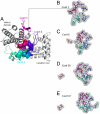Use of allostery to identify inhibitors of calmodulin-induced activation of Bacillus anthracis edema factor
- PMID: 20534570
- PMCID: PMC2895076
- DOI: 10.1073/pnas.0914611107
Use of allostery to identify inhibitors of calmodulin-induced activation of Bacillus anthracis edema factor
Abstract
Allostery plays a key role in the regulation of the activity and function of many biomolecules. And although many ligands act through allostery, no systematic use is made of it in drug design strategies. Here we describe a procedure for identifying the regions of a protein that can be used to control its activity through allostery. This procedure is based on the construction of a plausible conformational path, which describes protein transition between known active and inactive conformations. The path is calculated by using a framework approach that steers and markedly improves the conjugate peak refinement method. The evolution of conformations along this path was used to identify a putative allosteric site that could regulate activation of Bacillus anthracis adenylyl cyclase toxin (EF) by calmodulin. Conformations of the allosteric site at different steps along the path from the inactive (free) to the active (bound to calmodulin) forms of EF were used to perform virtual screenings and propose candidate EF inhibitors. Several candidates then proved to inhibit calmodulin-induced activation in an in vitro assay. The most potent compound fully inhibited EF at a concentration of 10 microM. The compounds also inhibited the related adenylyl cyclase toxin from Bordetella pertussis (CyaA). The specific homology between the putative allosteric sites in both toxins supports that these pockets are the actual binding sites of the selected inhibitors.
Conflict of interest statement
The authors declare no conflict of interest.
Figures

 in the inactive and active forms, respectively), EF and CaM are drawn in cartoon format. Switches A, B, and C in EF are highlighted in blue, orange, and magenta, respectively.
in the inactive and active forms, respectively), EF and CaM are drawn in cartoon format. Switches A, B, and C in EF are highlighted in blue, orange, and magenta, respectively.


Similar articles
-
Molecular motions as a drug target: mechanistic simulations of anthrax toxin edema factor function led to the discovery of novel allosteric inhibitors.Toxins (Basel). 2012 Aug;4(8):580-604. doi: 10.3390/toxins4080580. Epub 2012 Jul 31. Toxins (Basel). 2012. PMID: 23012649 Free PMC article. Review.
-
The adenylyl cyclase activity of anthrax edema factor.Mol Aspects Med. 2009 Dec;30(6):423-30. doi: 10.1016/j.mam.2009.06.001. Epub 2009 Jun 26. Mol Aspects Med. 2009. PMID: 19560485 Free PMC article. Review.
-
Protein-protein docking and analysis reveal that two homologous bacterial adenylyl cyclase toxins interact with calmodulin differently.J Biol Chem. 2008 Aug 29;283(35):23836-45. doi: 10.1074/jbc.M802168200. Epub 2008 Jun 26. J Biol Chem. 2008. PMID: 18583346 Free PMC article.
-
Different Roles of N-Terminal and C-Terminal Domains in Calmodulin for Activation of Bacillus anthracis Edema Factor.Toxins (Basel). 2015 Jul 13;7(7):2598-614. doi: 10.3390/toxins7072598. Toxins (Basel). 2015. PMID: 26184312 Free PMC article.
-
Inhibition of the adenylyl cyclase toxin, edema factor, from Bacillus anthracis by a series of 18 mono- and bis-(M)ANT-substituted nucleoside 5'-triphosphates.Naunyn Schmiedebergs Arch Pharmacol. 2012 Jan;385(1):57-68. doi: 10.1007/s00210-011-0688-9. Epub 2011 Sep 24. Naunyn Schmiedebergs Arch Pharmacol. 2012. PMID: 21947230
Cited by
-
A Robust and Sensitive Spectrophotometric Assay for the Enzymatic Activity of Bacterial Adenylate Cyclase Toxins.Toxins (Basel). 2022 Oct 8;14(10):691. doi: 10.3390/toxins14100691. Toxins (Basel). 2022. PMID: 36287960 Free PMC article.
-
Designed mono- and di-covalent inhibitors trap modeled functional motions for Trypanosoma cruzi proline racemase in crystallography.PLoS Negl Trop Dis. 2018 Oct 29;12(10):e0006853. doi: 10.1371/journal.pntd.0006853. eCollection 2018 Oct. PLoS Negl Trop Dis. 2018. PMID: 30372428 Free PMC article.
-
PASSer: fast and accurate prediction of protein allosteric sites.Nucleic Acids Res. 2023 Jul 5;51(W1):W427-W431. doi: 10.1093/nar/gkad303. Nucleic Acids Res. 2023. PMID: 37102691 Free PMC article.
-
Molecular motions as a drug target: mechanistic simulations of anthrax toxin edema factor function led to the discovery of novel allosteric inhibitors.Toxins (Basel). 2012 Aug;4(8):580-604. doi: 10.3390/toxins4080580. Epub 2012 Jul 31. Toxins (Basel). 2012. PMID: 23012649 Free PMC article. Review.
-
Local Geometry and Evolutionary Conservation of Protein Surfaces Reveal the Multiple Recognition Patches in Protein-Protein Interactions.PLoS Comput Biol. 2015 Dec 21;11(12):e1004580. doi: 10.1371/journal.pcbi.1004580. eCollection 2015 Dec. PLoS Comput Biol. 2015. PMID: 26690684 Free PMC article.
References
-
- Kitchen D, Decornez H, Furr J, Bajorath J. Docking and scoring in virtual screening for drug discovery: Methods and applications. Nat Rev Drug Discov. 2004;3:935–949. - PubMed
-
- Pauli I, Timmers L, Caceres R, Soares M, de Azevedo W. In silico and in vitro: Identifying new drugs. Curr Drug Targets. 2008;9:1054–1061. - PubMed
-
- Rarey M, Kramer B, Lengauer T, Klebe G. A fast flexible docking method using an incremental construction algorithm. J Mol Biol. 1996;261:470–489. - PubMed
-
- Abagyan R, Totrov M, Kuznetsov D. ICM: A new method for protein modeling and design: Applications to docking and structure prediction from the distorted native conformation. J Comput Chem. 1994;15:488–506.
Publication types
MeSH terms
Substances
LinkOut - more resources
Full Text Sources
Molecular Biology Databases

